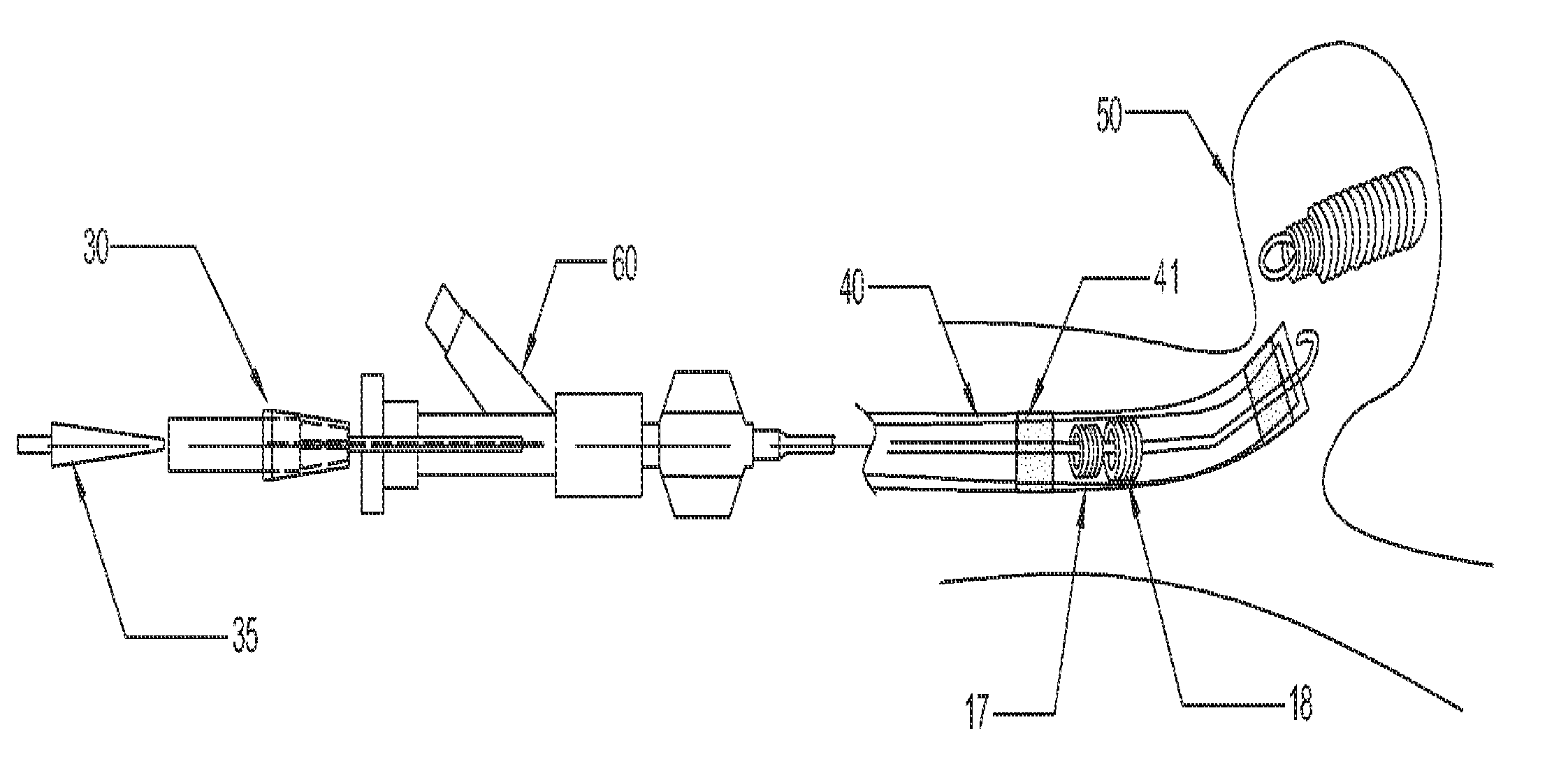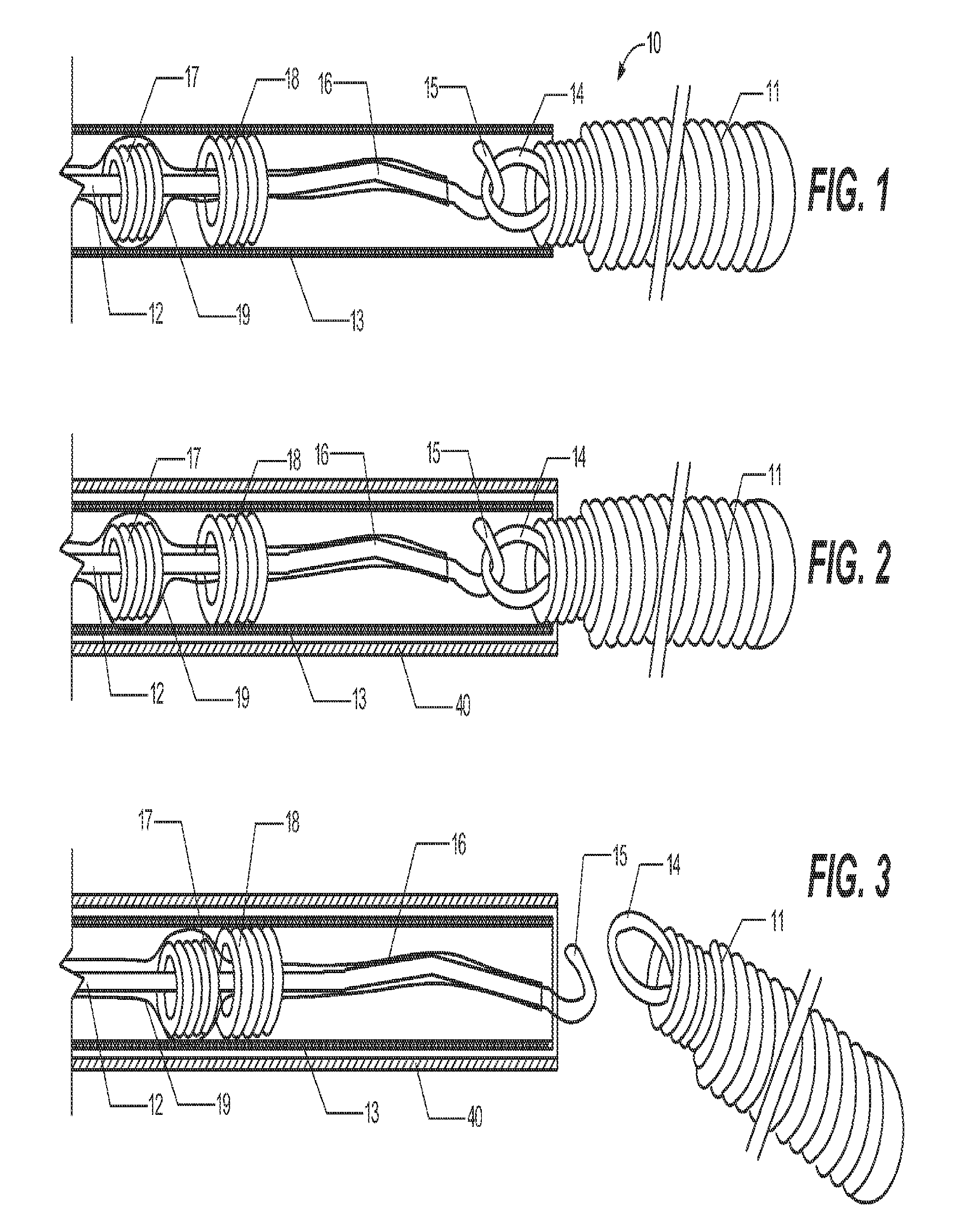[0014]Briefly, and in general terms, the present invention presents a delivery assembly and methods for accurately and rapidly deploying an
occlusion device at a target location within a patient. Preferably, the target location is within a patient's vasculature. The delivery assembly comprises an occlusive
implant device that is an occlusive coil, a pushwire for pushing and deploying the occlusive coil through an elongated and flexible delivery sleeve, a first member of an
interlocking mechanism, the first member being located at the distal end of the pushwire, and a second member of an interlocking mechanism, the second member being located at the proximal end of the occlusive coil. Optionally, the delivery assembly comprises a pushwire locking device located at the proximal end of the pushwire to prevent any relative movement between the pushwire and the delivery sleeve during
delivery procedure. Optionally, two markers are attached to the delivery assembly in a configuration that allows for advancement of the pushwire through a delivery sleeve to the
target site, but that contact each other to prevent over-extending of the pushwire / occlusive coil into the
aneurysm. Preferably, the
distal portion of the pushwire is coated with PTFE (
Polytetrafluoroethylene) to provide a lubricous surface to aid the
catheter in moving in the
artery.
[0015]In one embodiment of the present invention, the occlusive coil is attached to the distal end of the pushwire of the delivery assembly through interlocking mechanism. The pushwire can be a tapered wire, tapered at its distal end to enhance pushability of said pushwire and to enhance trackability of the attached occlusive coil. In a preferred aspect of this embodiment, the interlocking mechanism comprises a first locking member and a second locking member. Preferably, said first locking member is a hook and said second locking member is a loop. Alternatively, said first locking member is a loop and said second locking member is a hook. The hook member is preferably a J-shaped hook, though alternative shapes such as Y-shapes, S-shapes and the like are useful.
[0017]Further, the invention advantageously incorporates a two marker
system to enhance the precision of the deployment of the occlusive device to the
target site. For this two marker
system, there are attached markers to each of the pushwire and the delivery sleeve individually. Each of these markers may be made of a radiopaque material selected from
platinum, gold,
tungsten,
rhenium,
palladium,
rhodium, and alloys thereof, or any combination thereof. The presence of two markers serves several purposes: First, a radiopaque marker is visible under radiographic conditions, thereby allowing the physician to identify the position of both the pushwire and the delivery sleeve to determine their relative positions within the microcatheter. Second, during deployment of the occlusive coil at the point when the interlocking joint is being pushed out from the delivery sleeve, the proximal marker, which is fixed onto the pushwire, will be pushed forward but will be blocked by the distal marker which is fixedly attached onto the inner surface of the delivery sleeve. This blocking prevents any further advancement of the pushwire into the
aneurysm and prevents over-deployment of the pushwire into the target location. Using these radiopaque markers in such a configuration allows the occlusive coil to be precisely placed inside the
aneurysm while also operating to prevent over-extending of the pushwire causing further injury to the aneurysm. Hence the two markers
system acts as a safety catch to prevent over-extending of the pushwire.
[0021]Another aspect of the invention is that the delivery sleeve is made of polymeric material comprising one or more of,
Polyimide,
polyether block amide, nylon, PTFE (
Polytetrafluoroethylene), Polyetheretherketone (PEEK) and block copolymers thereof. Further, the delivery sleeve can be formed of two or more materials. For example, a proximal section of the delivery sleeve can be made of a first material and the distal section from a second material. A proximal section made of a polymide and a distal section made of nylon is a more specific example, though is provided only for illustration and not limitation. Additionally, the delivery sleeve can further comprise a reinforced wire to become braided tubing so to enhance the kink-resistance of the delivery sleeve. Alternatively, the surface of the delivery sleeve can further comprise of a layer of
hydrophilic coating to enhance the trackability of the delivery assembly, which can be many different types of well-known hydrophilic
polymer such as polyvinyl compounds, polyurethanes, polyacrylates or copolymers of vinyl compounds and acrylates or anhydrides, especially polyethyleneoxide,
polyvinylpyrrolidone, and
polyurethane. In a further alternative the lumen of said delivery sleeve can comprise a PTFE liner. Preferably, said PTFE liner provides a lubricated inner surface that facilitates navigation of a pushwire and occlusive device through said lumen of said delivery sleeve.
 Login to View More
Login to View More  Login to View More
Login to View More 


